| Part 1: Genesis
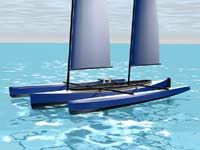 |
The XCR,
designed by Chris Ostlind |
I showed up at Chris’ shop hefting a pair of
huge Granato’s mozzarella and tomato sandwiches,
the staple for our boat-centric lunch meetings, but
I couldn’t let myself sit and eat. I was too
excited to get another look at the hull of what I
had just learned would be my next boat. To my relief,
it was just as I remembered it; surprisingly huge
compared to my Mill Creek.
When my boys were small I could actually fit my entire
family of four into the 8-foot cockpit of my 16 ½
foot Mill Creek kayak-cum-trimaran with reasonable
comfort. But those days are long gone and The Guys
are now 12 and 14 years old. The XCR, even though
it’s only two feet longer than the Mill Creek,
is built around a high-capacity expedition canoe hull
that will be spacious by comparison, especially when
anchoring out and sleeping, either by myself or with
one of my boys along stretched end-to-end. On family
outings the kids can lounge out on the trampolines.
Boy, did they perk up when I mentioned trampolines.
They had visions of themselves bouncing along and
performing all kinds of aerial acrobatics as we sailed
off to the horizon.
I’ve been thinking more about trailering since
my spine started trying to tell me that it’s
time to lower my expectations for cartopping. I swear
the boat hanging from my garage ceiling gains 20 pounds
every year. If I’m going to use a trailer anyway,
I might as well go for a bigger boat. Not BIG, mind
you, just bigger. Now that I’ve built half a
dozen or so small boats I’ve learned a lot about
what I like and don’t like, so the time seemed
ripe to start thinking about a new boat with a lot
of the things from the “I like” list.
For starters, I’m an unabashed trimaran geek,
so there was no question about how many hulls it would
have.
Because of storage concerns, my next boat and its
trailer would have to fit through a 55-inch wide gate
and store in a 20-footish long space. Even though
it will live on a trailer, I still wanted it to be
light, so I can move it around my yard and launch
it either with a vehicle or by hand. I wanted it to
be bullet-proof-sturdy, I wanted it to be fast, and
I wanted it to be a Chris Ostlind trimaran.
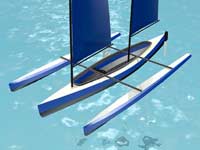 |
Click thumbnails
for larger views |
About Chris
I always have at least one of Chris Ostlind’s
designs taped up on the wall in my shop. I really
want to build one myself, but I just don’t have
the time to dive into a big project right now. I told
Chris what I was looking for and asked him if there
might be a chance I could get him to build me a boat,
or at least some of the major components, and before
you know it I’m handing over the down payment
for the XCR that’s already gestating in his
shop.
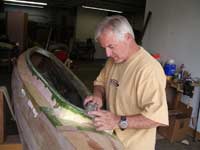 |
Chris lays up
the cockpit coaming on a form that he carved
from rigid foam |
Chris, besides being a good friend, is an all-around
impressive guy and a modern renaissance man of sorts.
He’s also one of the most prolific, versatile
and observant boat designers around. What a treat
to have the designer actually build this boat for
me, especially when he’s a craftsman of Chris’
caliber. A nod of gratitude to whatever weird chain
of events brought Chris to the high deserts of Utah,
an unlikely home for a gifted boat designer, indeed.
The XCR
The XCR is an ideal expedition boat. With a main
hull inspired by Verlen Kruger’s Cruiser canoe,
it’s a sturdy craft that’s designed to
stand up to journeys of thousands of miles. It has
a deep, voluminous cockpit with a high carbon composite
coaming and tubular thwarts, also of carbon fiber,
that double as sleeves for the outrigger beams (akas,
for those who prefer the Polynesian names for things).
And nothing gives me more peace-of-mind in cold water
than a pair of large, buoyant outrigger hulls (amas).
The construction is sturdy and lightweight. Impressively
so. The main hull, which only weights sixty-something
pounds, is made of 4mm Okoume marine ply, layered
with 6 oz. fiberglass cloth set in epoxy inside and
out. The joints are filleted and reinforced with additional
2” strips of bias-cut fiberglass. The side decks
are reinforced with rows of heavy-duty hanging knees,
which are set closer together at the thwarts to better
distribute the loads from the outriggers. Sturdy fore
and aft decks are reinforced with carbon fiber. It’s
a marvel of strength and weight economy. Here’s
what Chris has to say about it:
“The use of carbon fiber in this boat
is because of a personal decision to build a light,
but very strong craft for Kellan.. The carbon is
used in localized application zones where loadings
are potentially high and a high strength to weight
ratio specific to the material is beneficial. You
see it on this boat in the aka beams, thwart tubes
and coaming which are all subject to potential high
loadings from the sailing application of this design.
“Let's face it, carbon also has a very
high coolness factor. All three of these load path
areas on the boat could just as easily be addressed
with a glass, or wood and glass coaming, along with
aluminum akas and aluminum or glass thwart tubes.
The under deck areas around the thwart tubes are
re-enforced with an extra layer of 6 oz. glass and
additional red cedar knees to spread the loads of
the aka mounting points.”
To tell you the truth, I feel kind of lazy, being
the client and not doing any of the work myself, but
on the other hand it’s really a great ride,
kicking back and watching Chris work his magic at
things that would leave me scratching my head.
 |
The oak bow
handle is a nice design flair |
This will be a fun boat for day sailing to be sure,
but it will also be a sturdy vehicle for serious minimalist
adventuring on the Great Salt Lake and some of my
other favorite haunts, like cruising the shores of
Jackson Lake in the shadows of the Tetons and gliding
though the majestic canyons of Lake Powell. But for
this boat I’m also thinking of adventures farther
from home. For starters, I have my eyes set on the
San Juan Islands and The Sea of Cortez.
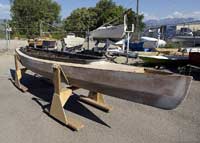 |
The XCR main
hull nears completion. Chris built these handy
cradles to support the boat and move it easily
around on castors |
Why a Tri?
Every now and then a monohull vs. multihull thread
pops up on one of the Yahoo groups and often builds
to a near-religious fervor. You get the impression
that any day these folks, monomen and multigeeks alike,
are likely to haul their tiny plywood boats down the
seashore and head off for the Roaring Forties, and
that their survival depends entirely on how many hulls
they have in the water. Anyone in the opposing camp
is surely headed for certain disaster.
For me it mostly down to this:
First, if the water is 40 degrees, especially if
my kids are aboard, a ten-foot beam brings me a lot
of peace of mind about the possibility of anyone ending
up in the drink. Remember what I said about learning
what I like and don’t like about boats? Well,
I like small, lightweight boats but I DON’T
like capsizing. Yes, you can capsize a trimaran –you
see it in those dramatic racing videos - but a cruising
tri sailed conservatively on protected waters is very
hard to get upside down. And a trimaran, since it
still has a real boat hull in the middle, gives you
a place to hunker down out of the weather.
Second, a multihull can be built tough yet remain
extremely lightweight. No ballast needed. The XCR
is just the right size that it can be launched anywhere
you can get to water. I’ll use a ramp when I
can, but if there’s no proper ramp I’ll
wheel the trailer to the water by hand. And when even
that isn’t an option, I can carry the hulls
and rigs down to the shore and assemble them on the
beach.
Third, and I consider this a bonus, if it will do
12 to 15 knots I have a better chance of getting to
safety ahead of the storm.
The XCR also has some interesting hull configuration
options. The akas are built in sections that snap
together easily with the same kind of spring buttons
that are used for adjustable tent poles. For storage
and transportation you take the center section out
of each aka and reattach the amas close to the main
hull. Clean and simple.
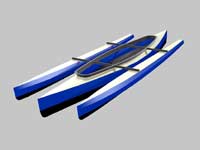 |
The XCR in trailering/Storage
configuration |
Alternate Propulsion
On it’s own, the XCR’s main hull is
a superb expedition canoe, so it glides along very
well with a couple of single blade canoe paddles.
When I want to use the XCR as a motorboat, I’ll
simply leave it in the narrower trailering configuration
and clamp on the outboard for a very light but stable
craft that will skim along quite impressively on only
2 horses.
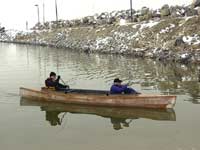 |
The XCR gets
its first paddling test in the icy water of
the Great Salt Lake marina |
Decisions
We had to decide on the sail plan pretty early in
the build because the mast locations would dictate
where Chris would place the thwarts/aka tubes, since
they would also double as mast partners. Chris was
very patient as I waffled, hemmed and hawed, and considered
just about everything from high-tech roller-reefers
to classic gunters rigs. In the end we settled on
a cat ketch plan with a pair of identical, fully-battened
high-aspect sails slotted into unstayed aluminum masts.
These can be used in tandem as a cat ketch rig, or
one sail can be stowed and the other moved to a central
mast step. In addition, both sails will have two sets
of reef points. This combination of sail configurations
will give me all kinds of options for dealing with
any kind of weather.
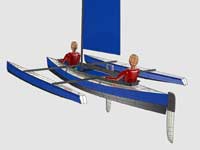 |
One rig stowed
as a simple way of reducing canvas |
You can also transfer one of these same rigs to several
some of Chris’ smaller designs, so when I get
around to building an ultralight solo boat one of
these days (I’m thinking of Chris’ Solo14),
I can use one of my XCR rigs for that as well.
Once the sail plan was locked down I ordered the
sails from Stuart Hopkins of Dabbler Sails. Chris
placed an order for the mast components and moved
onto his next task, which was to epoxy the thwart
tubes in place and reinforce them.
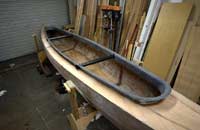 |
The thwarts
tubes are installed. These double as mounting
sleeves for the outriggers |
Once that was done we had a finished canoe on our
hands and Chris thought it would be a shame to not
take her out for a paddle, despite the fact that it
was the middle of January in the Rocky Mountains.
So, one cryogenic Saturday afternoon we headed out
to the Great Salt Lake marina - where the water was
still liquid - and plopped her into the lake without
much ceremony. Chris’ wife Lorrie was kind enough
come along and snap pictures. She did jumping jacks
to keep warm while we launched and climbed aboard.
The air temperature was 25 degrees F and the water
was a balmy 26. That’s colder than the water
at the poles, mind you, due to the high salt content.
It was a strange, hazy day and the water and sky blended
into a uniform horizonless void that gave us the sensation
of paddling off into some kind of ethereal Twilight
Zone. Not that that’s necessarily a bad thing.
It was a short trip; we hugged the shore for a while
and then headed out into the lake and took a turn
around the nearest buoy before turning back for the
marina. Chris gave me the willies for a moment when
he half-stood to switch from a kneeling to as sitting
position, but the XCR proved plenty stable. There’s
a lot of comfort in knowing that the quarter-inch
shell between you and a 26 degree plunge is solid
and reliable. I’m looking forward to a long
and intimate friendship with this boat.
 |
Paddling the
XCR into the void |
In the next article we’ll see the XCR blossom
into a trimaran and get her wings.
XCR
Plans available from Duckworks

Other Articles by Kellan Hatch:
|